Zhenglun Kong
TxAgent: An AI Agent for Therapeutic Reasoning Across a Universe of Tools
Mar 14, 2025Abstract:Precision therapeutics require multimodal adaptive models that generate personalized treatment recommendations. We introduce TxAgent, an AI agent that leverages multi-step reasoning and real-time biomedical knowledge retrieval across a toolbox of 211 tools to analyze drug interactions, contraindications, and patient-specific treatment strategies. TxAgent evaluates how drugs interact at molecular, pharmacokinetic, and clinical levels, identifies contraindications based on patient comorbidities and concurrent medications, and tailors treatment strategies to individual patient characteristics. It retrieves and synthesizes evidence from multiple biomedical sources, assesses interactions between drugs and patient conditions, and refines treatment recommendations through iterative reasoning. It selects tools based on task objectives and executes structured function calls to solve therapeutic tasks that require clinical reasoning and cross-source validation. The ToolUniverse consolidates 211 tools from trusted sources, including all US FDA-approved drugs since 1939 and validated clinical insights from Open Targets. TxAgent outperforms leading LLMs, tool-use models, and reasoning agents across five new benchmarks: DrugPC, BrandPC, GenericPC, TreatmentPC, and DescriptionPC, covering 3,168 drug reasoning tasks and 456 personalized treatment scenarios. It achieves 92.1% accuracy in open-ended drug reasoning tasks, surpassing GPT-4o and outperforming DeepSeek-R1 (671B) in structured multi-step reasoning. TxAgent generalizes across drug name variants and descriptions. By integrating multi-step inference, real-time knowledge grounding, and tool-assisted decision-making, TxAgent ensures that treatment recommendations align with established clinical guidelines and real-world evidence, reducing the risk of adverse events and improving therapeutic decision-making.
RoRA: Efficient Fine-Tuning of LLM with Reliability Optimization for Rank Adaptation
Jan 08, 2025



Abstract:Fine-tuning helps large language models (LLM) recover degraded information and enhance task performance.Although Low-Rank Adaptation (LoRA) is widely used and effective for fine-tuning, we have observed that its scaling factor can limit or even reduce performance as the rank size increases. To address this issue, we propose RoRA (Rank-adaptive Reliability Optimization), a simple yet effective method for optimizing LoRA's scaling factor. By replacing $\alpha/r$ with $\alpha/\sqrt{r}$, RoRA ensures improved performance as rank size increases. Moreover, RoRA enhances low-rank adaptation in fine-tuning uncompressed models and excels in the more challenging task of accuracy recovery when fine-tuning pruned models. Extensive experiments demonstrate the effectiveness of RoRA in fine-tuning both uncompressed and pruned models. RoRA surpasses the state-of-the-art (SOTA) in average accuracy and robustness on LLaMA-7B/13B, LLaMA2-7B, and LLaMA3-8B, specifically outperforming LoRA and DoRA by 6.5% and 2.9% on LLaMA-7B, respectively. In pruned model fine-tuning, RoRA shows significant advantages; for SHEARED-LLAMA-1.3, a LLaMA-7B with 81.4% pruning, RoRA achieves 5.7% higher average accuracy than LoRA and 3.9% higher than DoRA.
Fully Open Source Moxin-7B Technical Report
Dec 08, 2024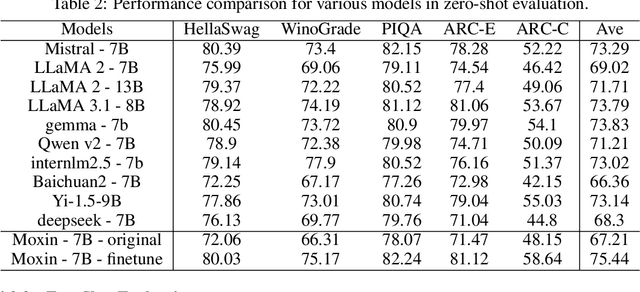
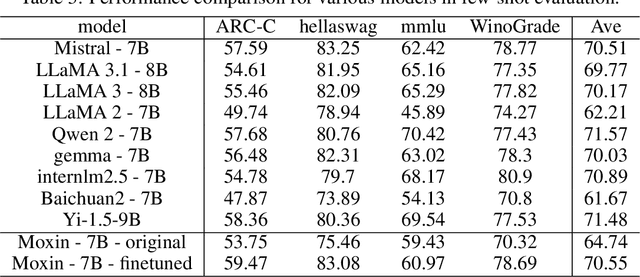
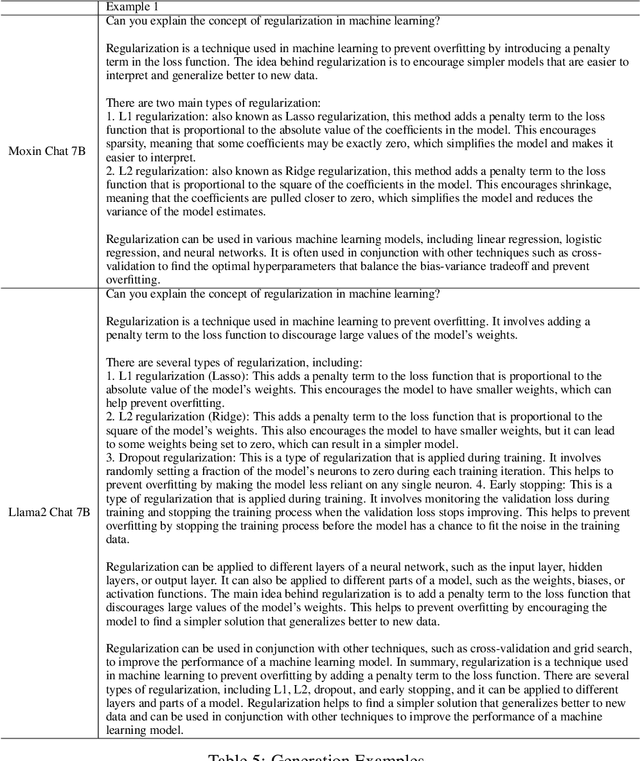
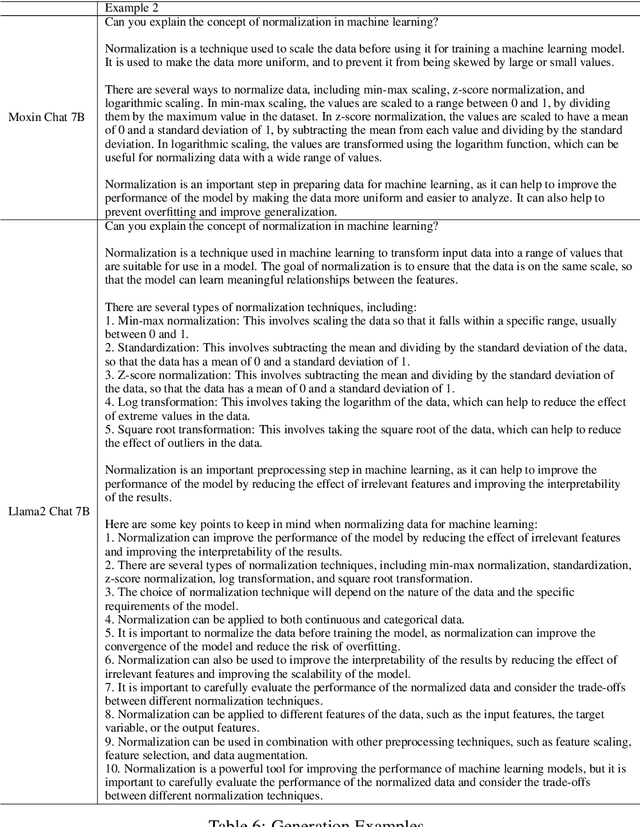
Abstract:Recently, Large Language Models (LLMs) have undergone a significant transformation, marked by a rapid rise in both their popularity and capabilities. Leading this evolution are proprietary LLMs like GPT-4 and GPT-o1, which have captured widespread attention in the AI community due to their remarkable performance and versatility. Simultaneously, open-source LLMs, such as LLaMA and Mistral, have made great contributions to the ever-increasing popularity of LLMs due to the ease to customize and deploy the models across diverse applications. Although open-source LLMs present unprecedented opportunities for innovation and research, the commercialization of LLMs has raised concerns about transparency, reproducibility, and safety. Many open-source LLMs fail to meet fundamental transparency requirements by withholding essential components like training code and data, and some use restrictive licenses whilst claiming to be "open-source," which may hinder further innovations on LLMs. To mitigate this issue, we introduce Moxin 7B, a fully open-source LLM developed in accordance with the Model Openness Framework (MOF), a ranked classification system that evaluates AI models based on model completeness and openness, adhering to principles of open science, open source, open data, and open access. Our model achieves the highest MOF classification level of "open science" through the comprehensive release of pre-training code and configurations, training and fine-tuning datasets, and intermediate and final checkpoints. Experiments show that our model achieves superior performance in zero-shot evaluation compared with popular 7B models and performs competitively in few-shot evaluation.
Fast and Memory-Efficient Video Diffusion Using Streamlined Inference
Nov 02, 2024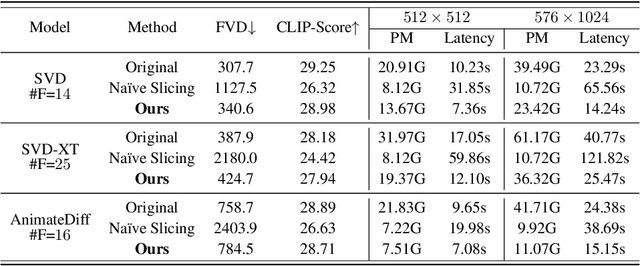
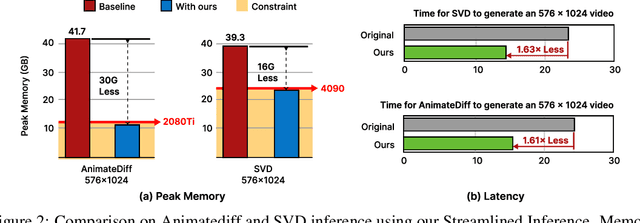

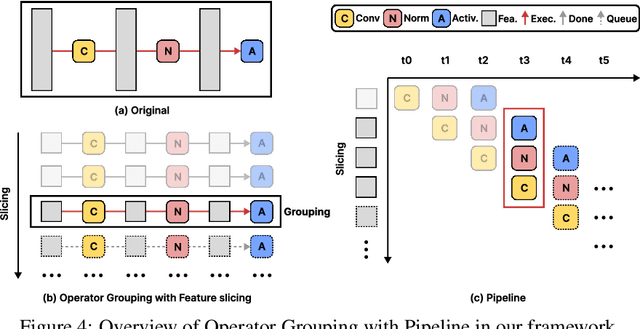
Abstract:The rapid progress in artificial intelligence-generated content (AIGC), especially with diffusion models, has significantly advanced development of high-quality video generation. However, current video diffusion models exhibit demanding computational requirements and high peak memory usage, especially for generating longer and higher-resolution videos. These limitations greatly hinder the practical application of video diffusion models on standard hardware platforms. To tackle this issue, we present a novel, training-free framework named Streamlined Inference, which leverages the temporal and spatial properties of video diffusion models. Our approach integrates three core components: Feature Slicer, Operator Grouping, and Step Rehash. Specifically, Feature Slicer effectively partitions input features into sub-features and Operator Grouping processes each sub-feature with a group of consecutive operators, resulting in significant memory reduction without sacrificing the quality or speed. Step Rehash further exploits the similarity between adjacent steps in diffusion, and accelerates inference through skipping unnecessary steps. Extensive experiments demonstrate that our approach significantly reduces peak memory and computational overhead, making it feasible to generate high-quality videos on a single consumer GPU (e.g., reducing peak memory of AnimateDiff from 42GB to 11GB, featuring faster inference on 2080Ti).
Pruning Foundation Models for High Accuracy without Retraining
Oct 21, 2024


Abstract:Despite the superior performance, it is challenging to deploy foundation models or large language models (LLMs) due to their massive parameters and computations. While pruning is a promising technique to reduce model size and accelerate the inference, the traditional pruning techniques can hardly be applied for LLMs as they need to finetune the model on the full dataset with multiple epochs consuming massive data and hardware resources. To deal with this problem, post-training pruning methods are proposed to prune LLMs in one-shot without retraining. However, their accuracy after pruning may suffer from certain performance degradation due to the lack of retraining with massive data. To address this issue, in this paper, we first formulate the post-training problem for layer-wise LLM compression to simultaneously prune multiple weights in LLMs. Next, we provide an optimal solution for this problem and design our post-training pruning algorithm for both unstructured and semi-structured sparsity. Our extensive experiments demonstrate the superior performance of the proposed methods in comparison to SOTA baselines across various LLM families including transformer-based LLMs and Mamba-based LLMs. Code link: https://github.com/piuzha/APT
Rethinking Token Reduction for State Space Models
Oct 16, 2024



Abstract:Recent advancements in State Space Models (SSMs) have attracted significant interest, particularly in models optimized for parallel training and handling long-range dependencies. Architectures like Mamba have scaled to billions of parameters with selective SSM. To facilitate broader applications using Mamba, exploring its efficiency is crucial. While token reduction techniques offer a straightforward post-training strategy, we find that applying existing methods directly to SSMs leads to substantial performance drops. Through insightful analysis, we identify the reasons for this failure and the limitations of current techniques. In response, we propose a tailored, unified post-training token reduction method for SSMs. Our approach integrates token importance and similarity, thus taking advantage of both pruning and merging, to devise a fine-grained intra-layer token reduction strategy. Extensive experiments show that our method improves the average accuracy by 5.7% to 13.1% on six benchmarks with Mamba-2 compared to existing methods, while significantly reducing computational demands and memory requirements.
Exploring Token Pruning in Vision State Space Models
Sep 27, 2024



Abstract:State Space Models (SSMs) have the advantage of keeping linear computational complexity compared to attention modules in transformers, and have been applied to vision tasks as a new type of powerful vision foundation model. Inspired by the observations that the final prediction in vision transformers (ViTs) is only based on a subset of most informative tokens, we take the novel step of enhancing the efficiency of SSM-based vision models through token-based pruning. However, direct applications of existing token pruning techniques designed for ViTs fail to deliver good performance, even with extensive fine-tuning. To address this issue, we revisit the unique computational characteristics of SSMs and discover that naive application disrupts the sequential token positions. This insight motivates us to design a novel and general token pruning method specifically for SSM-based vision models. We first introduce a pruning-aware hidden state alignment method to stabilize the neighborhood of remaining tokens for performance enhancement. Besides, based on our detailed analysis, we propose a token importance evaluation method adapted for SSM models, to guide the token pruning. With efficient implementation and practical acceleration methods, our method brings actual speedup. Extensive experiments demonstrate that our approach can achieve significant computation reduction with minimal impact on performance across different tasks. Notably, we achieve 81.7\% accuracy on ImageNet with a 41.6\% reduction in the FLOPs for pruned PlainMamba-L3. Furthermore, our work provides deeper insights into understanding the behavior of SSM-based vision models for future research.
Search for Efficient Large Language Models
Sep 25, 2024


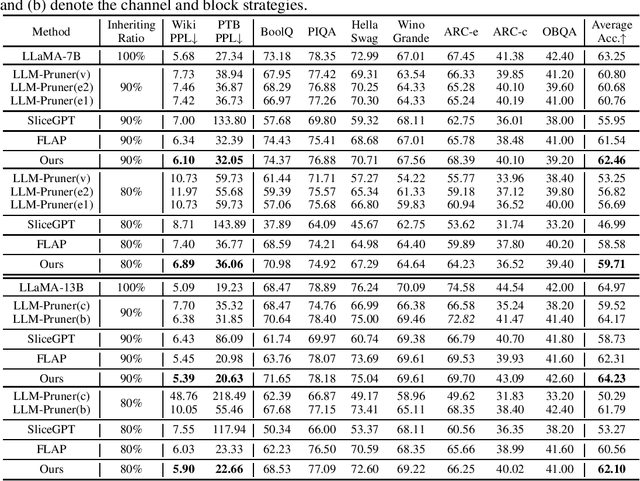
Abstract:Large Language Models (LLMs) have long held sway in the realms of artificial intelligence research. Numerous efficient techniques, including weight pruning, quantization, and distillation, have been embraced to compress LLMs, targeting memory reduction and inference acceleration, which underscore the redundancy in LLMs. However, most model compression techniques concentrate on weight optimization, overlooking the exploration of optimal architectures. Besides, traditional architecture search methods, limited by the elevated complexity with extensive parameters, struggle to demonstrate their effectiveness on LLMs. In this paper, we propose a training-free architecture search framework to identify optimal subnets that preserve the fundamental strengths of the original LLMs while achieving inference acceleration. Furthermore, after generating subnets that inherit specific weights from the original LLMs, we introduce a reformation algorithm that utilizes the omitted weights to rectify the inherited weights with a small amount of calibration data. Compared with SOTA training-free structured pruning works that can generate smaller networks, our method demonstrates superior performance across standard benchmarks. Furthermore, our generated subnets can directly reduce the usage of GPU memory and achieve inference acceleration.
Quasar-ViT: Hardware-Oriented Quantization-Aware Architecture Search for Vision Transformers
Jul 25, 2024

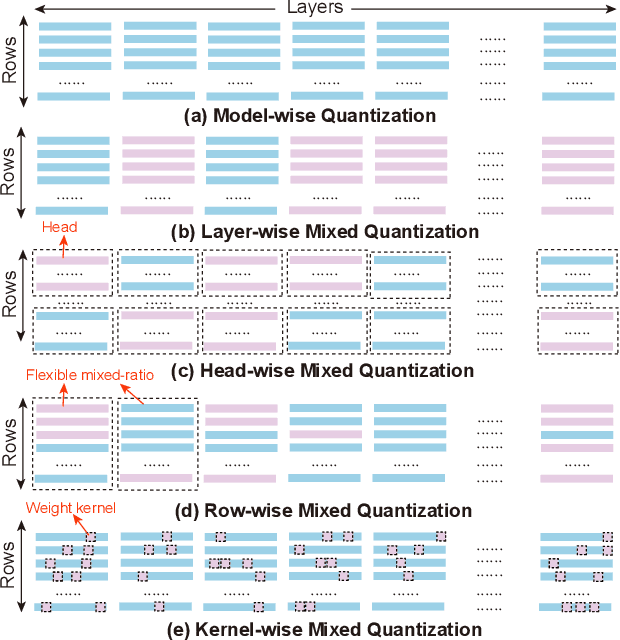

Abstract:Vision transformers (ViTs) have demonstrated their superior accuracy for computer vision tasks compared to convolutional neural networks (CNNs). However, ViT models are often computation-intensive for efficient deployment on resource-limited edge devices. This work proposes Quasar-ViT, a hardware-oriented quantization-aware architecture search framework for ViTs, to design efficient ViT models for hardware implementation while preserving the accuracy. First, Quasar-ViT trains a supernet using our row-wise flexible mixed-precision quantization scheme, mixed-precision weight entanglement, and supernet layer scaling techniques. Then, it applies an efficient hardware-oriented search algorithm, integrated with hardware latency and resource modeling, to determine a series of optimal subnets from supernet under different inference latency targets. Finally, we propose a series of model-adaptive designs on the FPGA platform to support the architecture search and mitigate the gap between the theoretical computation reduction and the practical inference speedup. Our searched models achieve 101.5, 159.6, and 251.6 frames-per-second (FPS) inference speed on the AMD/Xilinx ZCU102 FPGA with 80.4%, 78.6%, and 74.9% top-1 accuracy, respectively, for the ImageNet dataset, consistently outperforming prior works.
Efficient Pruning of Large Language Model with Adaptive Estimation Fusion
Mar 16, 2024Abstract:Large language models (LLMs) have become crucial for many generative downstream tasks, leading to an inevitable trend and significant challenge to deploy them efficiently on resource-constrained devices. Structured pruning is a widely used method to address this challenge. However, when dealing with the complex structure of the multiple decoder layers, general methods often employ common estimation approaches for pruning. These approaches lead to a decline in accuracy for specific downstream tasks. In this paper, we introduce a simple yet efficient method that adaptively models the importance of each substructure. Meanwhile, it can adaptively fuse coarse-grained and finegrained estimations based on the results from complex and multilayer structures. All aspects of our design seamlessly integrate into the endto-end pruning framework. Our experimental results, compared with state-of-the-art methods on mainstream datasets, demonstrate average accuracy improvements of 1.1%, 1.02%, 2.0%, and 1.2% for LLaMa-7B,Vicuna-7B, Baichuan-7B, and Bloom-7b1, respectively.
 Add to Chrome
Add to Chrome Add to Firefox
Add to Firefox Add to Edge
Add to Edge